What Is The Color Of Leaves That Contain Chlorophyll
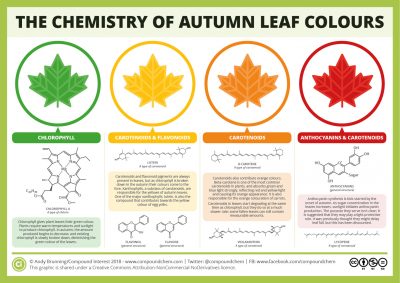
Plants produce an incredible diversity of pigments linked to many physiological and/or biological functions: photosynthesis, reproduction (to attract insects when pollinating flowers, for example). At that place are several types of pigments in leaves, mostly chlorophylls, carotenoids and anthocyanins.
Chlorophyll is responsible for the greenish colour of leaves (see Shedding light on Photosynthesis), but in autumn, some forests or crops lose their green colour and turned spectacularly coloured. In these leaves, chlorophyll disappears while other pigments – such every bit carotenoids, naturally present all year circular in the leaf – take not yet disappeared. This procedure begins as the length of the 24-hour interval decreases and temperatures drop. When the chlorophyll level decreases, the synthesis of anthocyanins – which are responsible for the red colour of the leaves – increases. These are the initial stages of leaf senescence that will atomic number 82 to leafage fall (Figure 1). [ane]
1. Leaf paint analysis
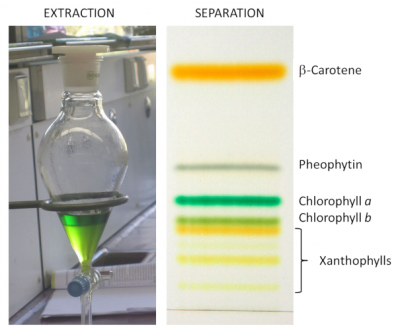
The pigments in the leaves are coloured molecules, soluble in organic solvents. They can be separated and analyzed using chromatographic techniques (thin layer, paper, HPLC, etc., Figure 2). [2] Afterwards extracting the pigments from each split ring, their absorption spectrum can be determined with spectrophotometers (see Figure 2).
two. Chlorophylls
Chlorophyll was isolated in 1816 past the French chemists and pharmacists Joseph Pelletier (1788-1842) and Joseph Caventou (1795-1877) who gave information technology its proper name in reference to the green (chloro) colour of the leaves (phyllum). This pigment is tightly associated to photosynthesis, it is synthesized within chloroplasts.
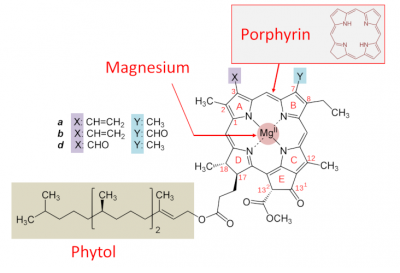
Chlorophyll consists of two parts :
- a porphyrin nucleus – containing nitrogen molecules – similar to that of the haemoglobin in our blood, but containing magnesium rather than iron; the presence of magnesium is essential for the functioning ;
- a hydrophobic tail with xx carbon atoms, phytol-, derived from isoprene and which allows the fixation to proteins of the photosystems.
Various chlorophylls (referred to as a, b, c, d, east and f) are distinguished from each other by distinct lateral groups (Figure 3). Chlorophyll a is nowadays in all aquatic and terrestrial plants. Conversely, some chlorophylls are specific to certain types: chlorophylls c1 and c2 be in brown algae, chlorophyll d is present in cyanobacteria.
The absorption of calorie-free past chlorophyll is due to the presence of numerous conjugated double bonds in its structure. Optimal functioning of the photosynthetic apparatus involves the permanent renewal of the protein-pigment complexes, as they dethrone rapidly during their activity.
three. Carotenoids
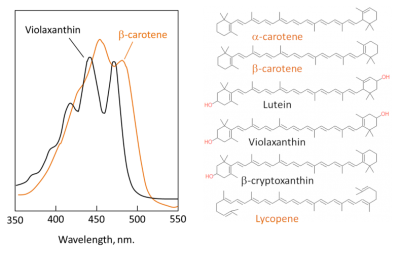
Carotenoids are yellow to orange or red pigments derived from isoprene* (run across Effigy 4). They are soluble in organic solvents. Synthesized in the various plastid types, their multifariousness is remarkable: more than a m distinct molecules have been described in living organisms (plants, animals, etc.). In leaves, one can find:
- carotenes, mainly β-carotene, which do not incorporate oxygen (Figure 4). The β-carotene does not actively contribute to photosynthesis but absorbs the backlog energy from the chlorophyll in society to avoid the germination of reactive oxygen species (superoxide O2• -, singlet oxygen •O-O•, hydroxyl HO•) which would destroy the leafage.
- Xanthophylls – which contain oxygen – are a subclass of carotenoids essential for photosynthesis and photosystem protection. Main xanthophylls in leaves are lutein, zeaxanthin, violaxanthin, etc. Pigments blot mainly in the blue wavelengths, hence their yellow colour (Figure four). Xanthophylls are precursors of plant hormones (abscisic acrid in item).
4. Anthocyanins
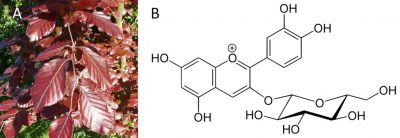
Anthocyanins (from the Greek anthos "flower" and kuanos "dark blue") are h2o-soluble pigments – they contain sugars – produced by the flavonoid pathway in the cytoplasm of the plant cell and so stored in vacuoles. [3]
Anthocyanins are responsible for the pink-carmine colour of most bloom petals, fruits and near all cerise leaves in the fall. Anthocyanins absorb visible low-cal in the bluish-light-green wavelengths. That's why they appear to u.s. in scarlet. Nevertheless, anthocyanins are sensitive to the pH of the medium in which they are stored and their colour varies from red (in an acidic medium) to bluish (as soon as the pH reaches neutrality).
Anthocyanins play a protective role past protecting the leaves from UV light.
Notes and References
Comprehend image. Maple leaves in the light. [Photo © Jacques Joyard]
[one] Autumn leaf pigments: https://i2.wp.com/world wide web.compoundchem.com/wp-content/uploads/2014/09/Chemistry-of-Fall-Leaves-2018.png
[2] Sjursnes B.J., Kvittinegn 50. & Schmid R. (2015) Normal and Reversed-Stage Thin Layer Chromatography of Greenish Leafage Extracts. J. Chem. Educ. , 92, i, 193-196.
[three] Selosse K.A. (2019) Les goûts et les couleurs du monde. Une histoire naturelle des tannins, de l'écologie à la santé. Actes Sud, ISBN 978-2-330-12677-3 (in french)
Source: https://www.encyclopedie-environnement.org/en/zoom/the-colour-of-leaves/
Posted by: stevensprou1983.blogspot.com


0 Response to "What Is The Color Of Leaves That Contain Chlorophyll"
Post a Comment